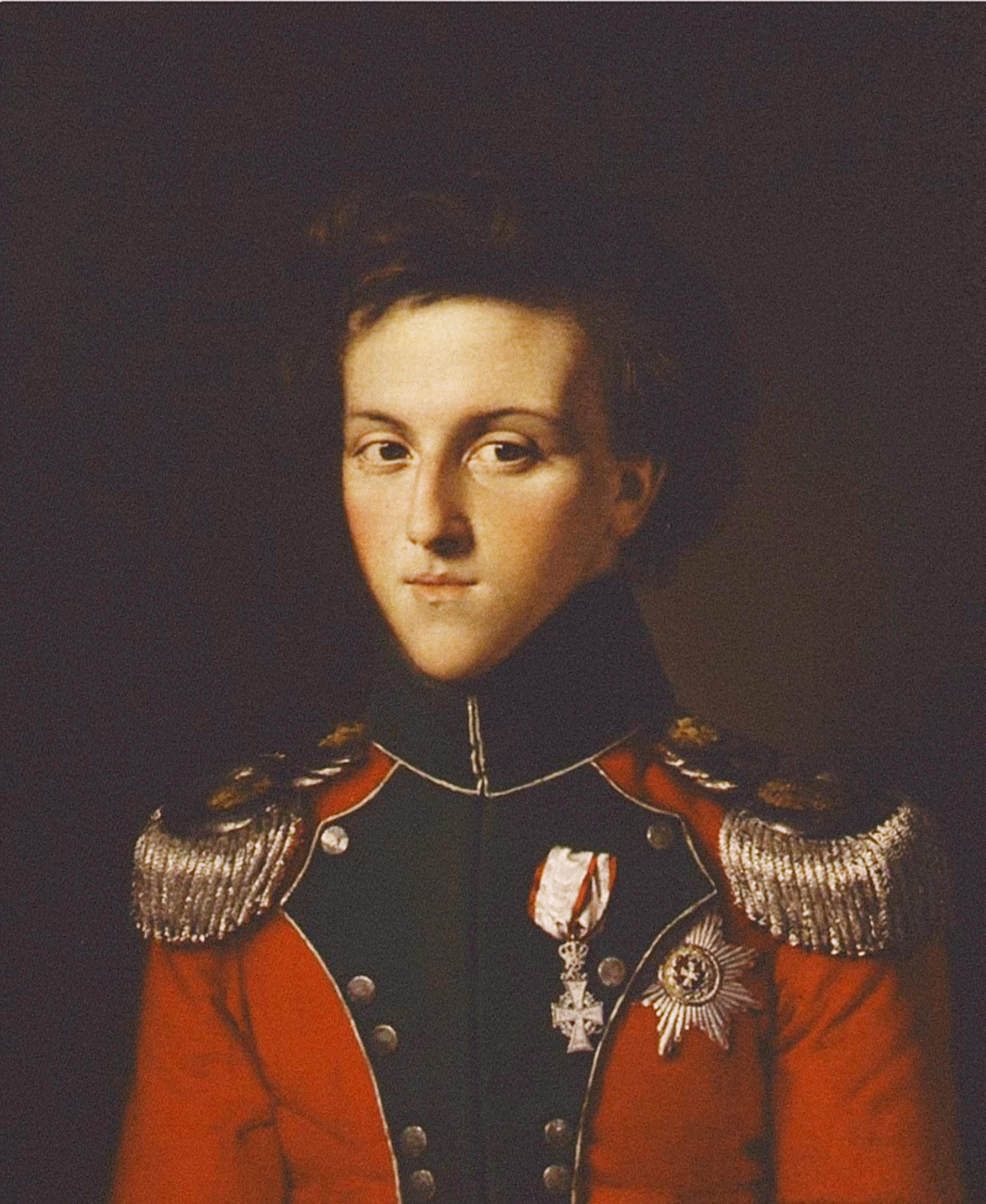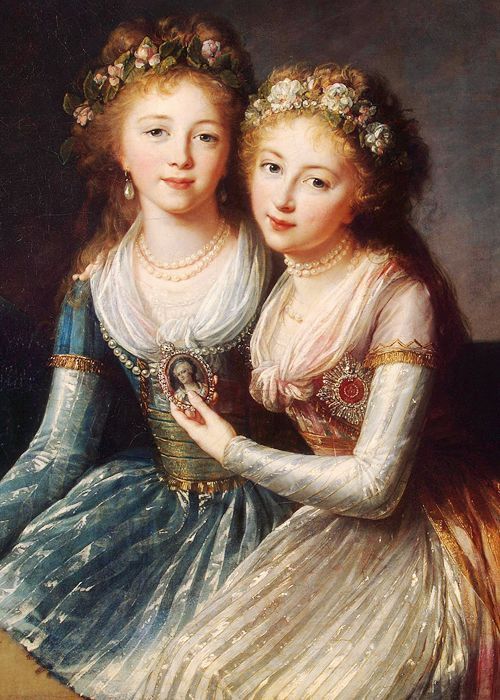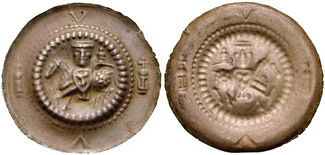|
Frederick Francis I Of Mecklenburg
Frederick Francis I (10 December 1756 – 1 February 1837) ruled over the German state of Mecklenburg-Schwerin, first as duke (1785–1815), and then as grand duke (1815–1837). Biography He was born in Schwerin, Duchy of Mecklenburg-Schwerin, to Duke Louis of Mecklenburg-Schwerin and Princess Charlotte Sophie of Saxe-Coburg-Saalfeld. Friedrich Franz succeeded his uncle Friedrich as duke of Mecklenburg-Schwerin in 1785. Following the Napoleonic Wars, Friedrich Franz was raised to the dignity of grand duke at the Congress of Vienna. Along with his cousin in Mecklenburg-Strelitz, he was known as one of the most reactionary German rulers. On his death in 1837 he was succeeded by his grandson, Grand Duke Paul Friedrich. Marriage and children On 1 June 1775 in Gotha, Friedrich Franz married Princess Louise of Saxe-Gotha-Altenburg. They had eight children: *Daughter (stillborn 7 May 1776), buried in the ''Schelfkirche St. Nikolai'' of Schwerin. [...More Info...] [...Related Items...] OR: [Wikipedia] [Google] [Baidu] |
Mecklenburg-Schwerin
The Duchy of Mecklenburg-Schwerin was a duchy in northern Germany created in 1701, when Frederick William and Adolphus Frederick II divided the Duchy of Mecklenburg between Schwerin and Strelitz. Ruled by the successors of the Nikloting House of Mecklenburg, Mecklenburg-Schwerin remained a state of the Holy Roman Empire along the Baltic Sea littoral between Holstein-Glückstadt and the Duchy of Pomerania. Origins The dynasty's progenitor, Niklot (1090–1160), was a chief of the Slavic Obotrite tribal federation, who fought against the advancing Saxons and was finally defeated in 1160 by Henry the Lion in the course of the Wendish Crusade. Niklot's son, Pribislav, submitted to Henry, and in 1167 came into his paternal inheritance as the first Prince of Mecklenburg. After various divisions of territory among Pribislav's descendants, Henry II of Mecklenburg (1266–1329) by 1312 had acquired the lordships of Stargard and Rostock, and bequeathed the reunified Mecklenburg land ... [...More Info...] [...Related Items...] OR: [Wikipedia] [Google] [Baidu] |
Lutheranism
Lutheranism is one of the largest branches of Protestantism, identifying primarily with the theology of Martin Luther, the 16th-century German monk and Protestant Reformers, reformer whose efforts to reform the theology and practice of the Catholic Church launched the Reformation, Protestant Reformation. The reaction of the government and church authorities to the international spread of his writings, beginning with the ''Ninety-five Theses'', divided Western Christianity. During the Reformation, Lutheranism became the state religion of numerous states of northern Europe, especially in northern Germany, Scandinavia and the then-Livonian Order. Lutheran clergy became civil servants and the Lutheran churches became part of the state. The split between the Lutherans and the Roman Catholics was made public and clear with the 1521 Edict of Worms: the edicts of the Diet (assembly), Diet condemned Luther and officially banned citizens of the Holy Roman Empire from defending or propagatin ... [...More Info...] [...Related Items...] OR: [Wikipedia] [Google] [Baidu] |
Frederick VII Of Denmark
Frederick VII (Frederik Carl Christian; 6 October 1808 – 15 November 1863) was King of Denmark from 1848 to 1863. He was the last Danish monarch of the older Royal branch of the House of Oldenburg and the last king of Denmark to rule as an absolute monarch. During his reign, he signed a constitution that established a Danish parliament and made the country a constitutional monarchy. Frederick's motto was ''Folkets Kærlighed, min Styrke'' (Danish for ''the People's Love, my Strength''). Family Frederick was born at Amalienborg Palace to Christian VIII of Denmark and Duchess Charlotte Frederica of Mecklenburg-Schwerin. His maternal grandparents were Friedrich Franz I, Grand Duke of Mecklenburg-Schwerin, and Luise, Duchess of Saxe-Gotha. Marriages The king's first two marriages both ended in scandal and divorce. He was first married in Copenhagen on 1 November 1828 to his second cousin Princess Vilhelmine Marie of Denmark, a daughter of King Frederick VI of Denmark. The ... [...More Info...] [...Related Items...] OR: [Wikipedia] [Google] [Baidu] |
Christian VIII Of Denmark
Christian VIII (18 September 1786 – 20 January 1848) was King of Denmark from 1839 to 1848 and, as Christian Frederick, King of Norway in 1814. Christian Frederick was the eldest son of Hereditary Prince Frederick, a younger son of King Frederick V of Denmark and Norway. As his cousin, King Frederick VI had no sons, Christian Frederick was heir presumptive to the throne from 1808. Early years Birth and family Prince Christian Frederick of Denmark and Norway was born on 18 September 1786 at Christiansborg Palace, the principal residence of the Danish Monarchy on the island of Slotsholmen in central Copenhagen. He was officially the eldest son of Hereditary Prince Frederick of Denmark and Norway and Duchess Sophia Frederica of Mecklenburg-Schwerin. His father was a younger son of the deceased King Frederick V of Denmark-Norway and his second wife, Duchess Juliana Maria of Brunswick-Wolfenbüttel, and his mother was a daughter of Duke Louis of Mecklenburg-Schwerin. In the family, ... [...More Info...] [...Related Items...] OR: [Wikipedia] [Google] [Baidu] |
Emil Leopold August, Duke Of Saxe-Gotha-Altenburg
Augustus, Duke of Saxe-Gotha-Altenburg (full name: ''Emil Leopold August'') (23 November 1772 — 17 May 1822), was a Duke of Saxe-Gotha-Altenburg, and the author of one of the first modern novels to treat of homoerotic love. He was the maternal grandfather of Prince Albert, consort of Queen Victoria. Early life He was born on 23 November 1772 in Gotha, the second son of Ernst II, Duke of Saxe-Gotha-Altenburg and Princess Charlotte of Saxe-Meiningen. In 1779 the death of his older brother Ernst made him heir to the duchy of Saxe-Gotha-Altenburg. In his youth he was very well educated, and his environment—sympathetic to the Jacobins—impressed on him the ideals of freedom, equality and fraternity. Reign He was already a supporter of Napoleon Bonaparte when he succeeded his father in 1804, which was an advantage in the Napoleonic wars. Saxe-Gotha-Altenburg joined the Rhine Confederation in 1806. When the French Army marched into his duchy in this year, August remained in Gotha ... [...More Info...] [...Related Items...] OR: [Wikipedia] [Google] [Baidu] |
Maria Feodorovna (Sophie Dorothea Of Württemberg)
Maria Feodorovna (russian: Мария Фёдоровна; née Duchess Sophie Dorothea of Württemberg; 25 October 1759 – 5 November 1828 S 24 October became Empress consort of Russia as the second wife of Emperor Paul I. She founded the Office of the Institutions of Empress Maria. Daughter of Duke Frederick Eugene of Württemberg and Princess Friederike of Brandenburg-Schwedt, Sophie Dorothea belonged to a junior branch of the House of Württemberg and grew up in Montbéliard, receiving an excellent education for her time. After Grand Duke Paul (the future Paul I of Russia) became a widower in 1776, King Frederick II of Prussia (Sophie Dorothea's maternal great-uncle) and Empress Catherine II of Russia chose Sophie Dorothea as the ideal candidate to become Paul's second wife. In spite of her fiancé's difficult character, she developed a long, peaceful relationship with Paul and converted to the Russian Orthodox Church in 1776, adopting the name ''Maria Feodorovna''. During ... [...More Info...] [...Related Items...] OR: [Wikipedia] [Google] [Baidu] |
Paul I Of Russia
Paul I (russian: Па́вел I Петро́вич ; – ) was Emperor of Russia from 1796 until his assassination. Officially, he was the only son of Peter III of Russia, Peter III and Catherine the Great, although Catherine hinted that he was fathered by her lover Sergei Saltykov.Aleksandr Kamenskii, ''The Russian Empire in the Eighteenth Century: Searching for a Place in the World'' (1997) pp 265–280. Paul remained overshadowed by his mother for most of his life. He adopted the Pauline Laws, laws of succession to the Russian throne—rules that lasted until the end of the Romanov dynasty and of the Russian Empire. He also intervened in the French Revolutionary Wars and, toward the end of his reign, added Kingdom of Kartli-Kakheti, Kartli and Kakheti in Eastern Georgia into the empire, which was confirmed by his son and successor Alexander I of Russia, Alexander I. He was ''de facto'' Grand Master (order), Grand Master of the Knights Hospitaller, Order of Hospitallers from ... [...More Info...] [...Related Items...] OR: [Wikipedia] [Google] [Baidu] |
Grand Duchess Elena Pavlovna Of Russia
Elena Pavlovna (; 24 December 1784 S 13 December– 24 September 1803) was born a grand duchess of Russia as the daughter of Paul I, Emperor of all the Russias and later became the Hereditary Grand Duchess of Mecklenburg-Schwerin as the wife of Frederick Louis of Meclenburg-Schwerin (1778–1819). Early life Grand Duchess Elena Pavlovna Romanova of Russia was born in Saint Petersburg in the Russian Empire as the fourth child and second daughter of Tsesarevich Paul Petrovich of Russia (1754–1801) and his second wife, Tsesarevna Maria Feodorovna, born Duchess Sophie Dorothea of Württemberg (1759–1828). Out of her nine siblings, Elena was closest to her older sister Alexandra Pavlovna (1783–1801). She was educated privately at home, for the first years, under the supervision of her paternal grandmother, Catherine the Great (1729–1796). Her education was focused mainly on fine arts, literature and music. Marriage and life in Schwerin Marriage In 1798, negotiati ... [...More Info...] [...Related Items...] OR: [Wikipedia] [Google] [Baidu] |
Schelf Church
The Schelf Church of St. Nicholas (german: Schelfkirche St. Nikolai) is an Evangelical Lutheran church dedicated to Saint Nicholas in the Schelfstadt quarter of Schwerin in Germany. The church is owned and used by a congregation within the Evangelical Lutheran Church in Northern Germany. It was originally built in 1238, but was rebuilt in 1713 in the Baroque style after destruction by a storm. It is the family burial place of the House of Mecklenburg-Schwerin, including Sophia Louise of Mecklenburg-Schwerin Sophia Louise of Mecklenburg-Schwerin (Sofie Luise; 6 May 1685 – 29 July 1735) was Queen consort in Prussia by marriage to King Frederick I of Prussia. She was famed for her beauty. Life Sophia Louise was the fourth child of Frederick, Duke .... Image:Schelfkirche Grundriss.png, Plan by Schlie Image:Schelfkirche Schwerin 1653.jpg, Schelfe and the medieval Schelf Church before 1651 File:Schwerin_Schelfkirche_Inschrift.jpg, Inscription Bibliography * Leonhard Christop ... [...More Info...] [...Related Items...] OR: [Wikipedia] [Google] [Baidu] |
Gotha (town)
Gotha () is the fifth-largest city in Thuringia, Germany, west of Erfurt and east of Eisenach with a population of 44,000. The city is the capital of the district of Gotha and was also a residence of the Ernestine Wettins from 1640 until the end of monarchy in Germany in 1918. The House of Saxe-Coburg and Gotha originating here spawned many European rulers, including the royal houses of the United Kingdom, Belgium, Portugal (until 1910) and Bulgaria (until 1946). In the Middle Ages, Gotha was a rich trading town on the trade route ''Via Regia'' and between 1650 and 1850, Gotha saw a cultural heyday as a centre of sciences and arts, fostered by the dukes of Saxe-Gotha. The first duke, Ernest the Pious, was famous for his wise rule. In the 18th century, the ''Almanach de Gotha'' was first published in the city. The publisher Justus Perthes and the encyclopedist Joseph Meyer made Gotha a leading centre of German publishing around 1800. In the early 19th century, Gotha was a bi ... [...More Info...] [...Related Items...] OR: [Wikipedia] [Google] [Baidu] |
Paul Friedrich Of Mecklenburg-Schwerin
Paul Friedrich (15 September 1800 – 7 March 1842) ruled as Grand Duke of Mecklenburg-Schwerin from 1837 to 1842. Biography He was born in Ludwigslust the son of Friedrich Ludwig, Hereditary Grand Duke of Mecklenburg-Schwerin and Grand Duchess Elena Pavlovna of Russia, and was the only surviving grandchild of Paul I of Russia who was born during the Tsar's lifetime. Paul Friedrich was educated at Geneva, Jena and Rostock. Paul Friedrich became heir-apparent to the throne of Mecklenburg-Schwerin in 1819, upon the death of his father, the Hereditary Grand Duke. On 1 February 1837 he succeeded his grandfather, Friedrich Franz I. His reign saw improvements in the infrastructure and judicial system of the Grand Duchy, as well as a change in the government's seat of residence from Ludwigslust to Schwerin. Nonetheless, Paul Friedrich was largely interested only in military matters and spent most of his time drilling his troops. As Paul Friedrich reached his middle age, he adop ... [...More Info...] [...Related Items...] OR: [Wikipedia] [Google] [Baidu] |
Congress Of Vienna
The Congress of Vienna (, ) of 1814–1815 was a series of international diplomatic meetings to discuss and agree upon a possible new layout of the European political and constitutional order after the downfall of the French Emperor Napoleon Bonaparte. Participants were representatives of all European powers and other stakeholders, chaired by Austrian statesman Klemens von Metternich, and held in Vienna from September 1814 to June 1815. The objective of the Congress was to provide a long-term peace plan for Europe by settling critical issues arising from the French Revolutionary Wars and the Napoleonic Wars without the use of (military) violence. The goal was not simply to restore old boundaries, but to resize the main powers so they could balance each other and remain at peace, being at the same time shepherds for the smaller powers. More fundamentally, strongly generalising, conservative thinking leaders like Von Metternich also sought to restrain or eliminate republicanism, ... [...More Info...] [...Related Items...] OR: [Wikipedia] [Google] [Baidu] |

.jpg)



.jpg)


